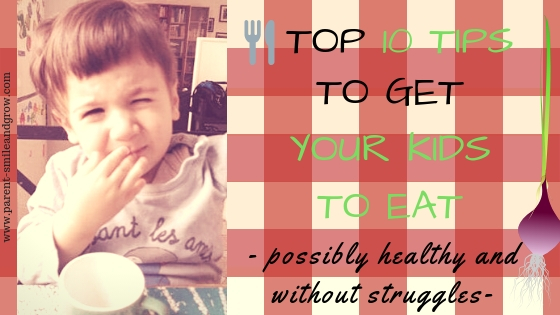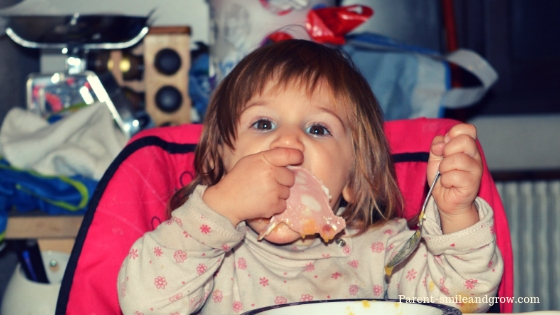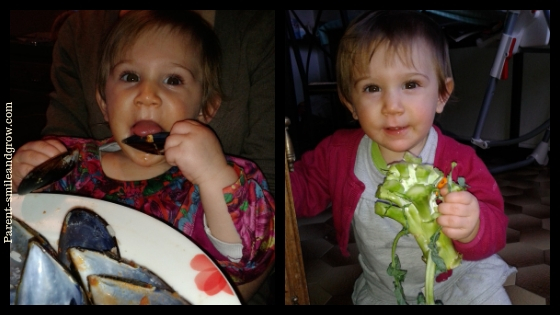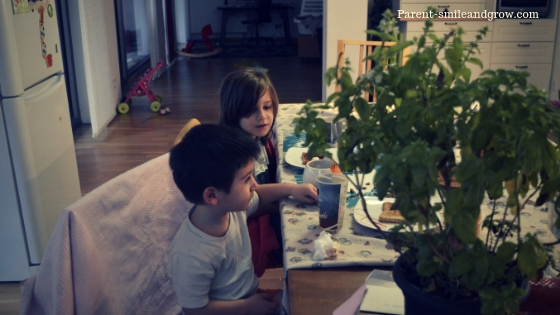
I don’t think I’m the only one who has to face this dilemma almost every day: how to make children eat more vegetables and less sugar and chocolate? I don’t always want to cook different dishes to satisfy everyone’s tastes. Moreover, we want to convince children to eat healthy, but do we know the effects of certain foods on behavior? Here’s my top tips to get your kids to eat (healthy), tricks and discoveries to experience calmer, peaceful meals !

Table of Contents
At the beginning, she would eat anything…
Let’s go back in time. When my eldest daughter was about 18 months, she ate everything. But really just about everything ! Ok, maybe not broccoli (I can understand). I remember when, during a vacation on the seaside (she had just turned 2), we went to the fishmonger and she looked so transfixed at the clams that the fishmonger gave her one that she kept happily between her hands. (And then tasted with pasta later 😉 )

Then, suddenly, something has changed. Little by little, she loved less and less food, and she eliminated one by one the products on her list. Up to the point when I could only choose between pasta with tomato sauce and pasta with olive oil and fish sticks (and the only vegetables were the tomatoes in her ketchup).
I’m not talking about the opposition’s phase, when children reaffirm their identity and they will oppose to anything we propose. Maybe it started because of that … but now, 2 years later, my daughter should be out of that phase! (Or maybe she’s in permanent opposition ..)
As this transition was slow, I did not understand my reaction at first. I would constantly search for something my kids would like. I did not want to force them to eat so as not to associate the meal with a power struggle. And sometimes, I was just tired and I did not want to argue.
…and now it’s an ever ending fight
Until the day I did realize that I had to practically cook different things for each of us; and when that did not happen, my children claimed their wishes as if they were in a restaurant. Then I suddenly rebelled : I did not want to give them this image of the maternal role.
Besides, when it was not possible to cook something proper, they ended up eating pasta for several days in a row (I know, it’s not the end of the world, but from a nutritional point of view .. questionable). What could I do?
Here’s an overview of all the experiences I’ve tried to convince my children to eat. A few of my tips to get your kids to eat (healthy).. Including numerous failures, reflections and small discoveries 😉
Tips to get your kids to eat (healthy) # 1 : Give the example
I can’t leave this one out … We cannot expect our children to eat things that disgust us! Eating with taste, also describing the aesthetic aspect, with emphatic exclamations from us, sends an important message.
I am convinced that this message will reach my children one day. I hope to be there to see it, because until now, they are happy to see us eat our soup and have their pasta on their plate!
Tips to get your kids to eat (healthy) # 2 : Let’s grow our own vegetables !
Eating our own vegetables … Nothing better than growing a small garden together! We can all pick up our zucchini and tomatoes, and the children will be happy to eat! An idyllic scene.
So wrong! Ok, they were still very young when we tried. But still. They were so excited in the shop while we were choosing our plants, but not as much when we had to work in the garden. Dirt and water everywhere; and after a few minutes: “Mom, I’m tired, Mom, I have to pee!” So I found myself with children who complained and needed me on one side, and on the other, chaos and other plants to take care of.
We did the vegetable garden anyway. I told myself that to reap the benefits of our work, it would be better. Children, are we going to the water? Yes, yes,cool! I’ll do it! (water everywhere except on the plants) The other one arrives: “Hey it’s my turn! I’ll do it now! Give it to me! ” Do I need to go on?
And when it was time to cook and eat? Bleah mama, I don’t like it!
Tips to get your kids to eat (healthy) # 3 : We can cook together
Ok. Maybe I need to involve them more in food preparation! Shall we cook together? One day, after their umpteenth request, I finally felt ready to give them not too sharp knives, and let them help me prepare the bell-peppers. They were delighted! But once on the table: “Mom yuck, I don’t like it!
Obviously, if we make a cake or cookies, the result is very different. Then they are willing to taste..

In one case, I must admit, the technique proved to be winning. The kids had asked for a meat sauce and my husband offered to prepare it with my daughter. As soon as she saw that to make her beloved sauce, we used onions, she went desperate. She begged us not to put them in, otherwise she couldn’t eat, the world is unfair, etc. Fortunately, we didn’t give in.
When we miraculously managed to convince her to taste (she was supposed to try the salt if I remember correctly), her eyes lit up: “But it’s very good! Dad I like onions!” And onions are also vegetables, aren’t they ?
Tips to get your kids to eat (healthy) # 4 : School’s involvement
The school expects parents to offer morning and afternoon snacks for all children. And this snack must contain only “healthy” foods, namely fruits, vegetables, bread, cheese and similar products. So there, as there’s nothing else to eat and everybody does eat, mine would also try !
One day at the supermarket, my daughter saw a cucumber. “Mom, you know I tasted it the other day at school, and I loved it!” Oh, that’s nice I thought! The following time, I bought a nice cucumber and I brought it to school for snack, all happy and thinking I’ve finally nailed one (what a naive I am, I know it).
My daughter’s face turned white. Then she began to cry desperately. “I DON’T WANT IT ! I DON’T LIKE THAT! I want something else!” To make it short … yeah, she eats cucumber.. if there’s nothing else and she’s starving. But mostly, she probably just sought her mother’s approval .
Tips to get your kids to eat (healthy) # 5 : Put some limits

As I told you before, one morning we discussed with the parents’ group at school about our daily challenges, and especially meal-time ones. In a glimpse, I suddenly realized how I try to satisfy everybody’s wishes and needs, I’d systematically prepare 2 or 3 different dishes.
I had given up trying to get them to taste new things, tired of their cries and tears. This is called a negative reinforcement. Involuntarily, I sent my children the message that if they were crying hard and producing enough dramatic scenes about the food, they could win the battle.
So, in agreement with my husband, I decided to roll up my sleeves (Strong of all the advice on cooperation ah! ) I prepared a main course and a few accompanying dishes; I put everything on the table.
Apparently, nothing attracted my daughter: there was a vegetable cake, a tomato salad and lentils. All accompanied by bread. “Eat what you want, you can choose. You don’t have to, but there’s nothing else; you should take at least one bite before you can say you don’t like it.
When the crying was too loud, we accompanied my daughter to her room (Reacting to the crying is always challenging..).
In the end, after calming down, she joined us again and between tears and sighs, she finally convinced herself to taste. And in the end, she even ate tomatoes.
The next day, same scene. But the cry lasted a little less (she probably didn’t want to stay closed in her room once again). Until not getting extra food has become (almost) automatic. Of course, they always try to ask pasta !

Tips to get your kids to eat (healthy) # 6 : Rethinking our priorities
Strategies and reflections vary according to our needs. First of all, we should ask ourselves: “Why does it bother me that my child doesn’t eat? Am I afraid that he won’t grow up well? Am I scared of not being a good parent, or that he won’t love me enough, or that my value and commitment won’t be recognized? ” Of course, the list can continue! And it all depends on what is most important to us.
For instance. At lunch, children eat at school and our system provides that older children can choose between three menus. So, on Sunday night, we go together to the computer to watch and choose the meals of the week. It would also be possible to bring a home lunch, as my daughter begs me from time to time.
I chose to avoid it. For two reasons:
-
because I just have enough things to do in the morning (or even the rest of the day);
-
I know that when she finds herself with the dish in front of her, and she’s with her friends, and under the mistress’s pressure, at least she tastes. She eats stuff she would refuse at home.
But why don’t they eat in the first place?
What is behind the child’s rejection of food? Potentially, a thousand reasons more or less hidden. For example, I found that when there are dishes that they particularly like at school, in the evening they are not very hungry; but they are in a good mood and more available to taste new things.
On the contrary, when they have not eaten much at lunch, if I prepare something new and / or green for dinner too, the game becomes a bit heavier. And frankly, I hadn’t even thought about all that at first.
This week my daughter was so grumpy. She barely said hello to me when I went to get her to school, she made a thousand stories, constantly quarreled with her brother .. and then yesterday, suddenly, she came back happy and smiling. Why? The first days she’d almost skipped lunch, or “discussed” with the teacher who had forced her to eat a little. Yesterday on the contrary, she had finished two plates .. And I was trying to probe the impenetrable mysteries of her behavior!
Tips to get your kids to eat (healthy) # 7 : discovering the links between food and behavior
Talking about behavior. I’m reading a very interesting book (in French, “Un zeste de conscience dans la cuisine” of psychotherapist Isabelle Filliozat) who talks about the link between psychology and what/how we eat. It offers curious reflections. For instance about the relationship between nutrition and behavior.
It cites, for example, a study published in 2007 on The Lancet*, which demonstrates the link between certain additives, in particular E211, and the increase in hyperactivity and attention deficit in children.
It also describes the effects of an excess of refined sugars (i.e. when not combined with fiber, and in excess regarding to one’s lifestyle) – glucose stimulates opioid production in the brain, which makes us addicted.
According to other studies, some people are particularly sensitive to sugar and are subject to huge mood swings ranging from euphoria to depression.
In short, our mood and thoughts also depend on the blood sugar, serotonin and beta-endorphins levels. Isn’t it incredible?
It also scares me a little. Because my children’s behavior (and therefore mine too !), may have a thousand possible causes …and they are all interconnected. It seems difficult to find a way out of the labyrinth!

When a child is particularly opposed, aggressive, hyperactive, grumpy, or on the contrary withdrawn, silent or depressed, if it is difficult for him to follow at school, I ask his parents about his diet and this even more so if he often has a stomach ache or trouble falling asleep. Not everything is psychic. Everything is psychosomatic …
Tips to get your kids to eat (healthy) # 8 : Exploring the Effect of Stress
Here’s what happens in practice. An event puts us under tension. Stress makes our intestine porous (by altering the bacterial balance).
Due to this porosity, some proteins can cross the intestinal walls. Glucose and milk proteins, in particular, are composed of opiate peptides that, crossing the intestinal walls, bind to the neuronal receptors, causing the same “addictive” reactions of sugar. Aggressiveness, difficulties in concentrating, or in falling asleep ..
Apparently, in sensitive people, these symptoms disappear immediately as soon as you stop introducing foods containing gluten and milk. The author has lived the thing in the first person, with one of her children, and the description she makes is quite meaningful.
The rest of the chapter continues by citing various studies and experiments, some with surprising results, that seem to prove a very strong link between nutrition and behavior.
Here’s one that struck me: in an American prison nearly 30 years ago, they removed refined sugar from the diet of 68 prisoners (of course the figure is statistically irrelevant). In the space of seven months, the number of serious accidents related to the behavior of prisoners has decreased by 45%.
Similar results have been obtained by regulating the level of fiber and vitamins, with significant improvements both for performance (at school or at work) and for mood..
Tips to get your kids to eat (healthy) # 9 : We should read the labels
I’m not ready to eliminate gluten, milk, nor cheese out of my diet, and I don’t want to convince you that this is the solution to the problem of getting your children to eat.
What I try to do in my own way (because my daughter sometimes has unexplained behaviors that fall into these categories) is to introduce whole foods, check labels, limit refined sugars and prefer the more “raw” ones, and explain, as much as possible, the importance of a balanced diet, in correspondence to an appropriate physical activity.
Then, of course, I have to face reality : the confrontation with peers, with the rest of the world, with the same will of my children, and not least, with my own habits (for example, I am bread dependent and for nothing in the world I would abandon my daily intakes !!)
Tips to get your kids to eat (healthy) # 10 : Let’s Check Our Relationship to Food
All this leads me to a more global reflection. That’s perhaps why whenever I’m stressed, I tend to compulsively eat bread. And behind the act of eating, of sharing food, there are small traps. Don’t you ever say or think any of these sentences :
-
“with all the effort I made to cook for you!”
-
“There are children in Africa who are starving and you don’t eat anything but throw away your food!”
I eat to please someone; I eat to show my love and to satisfy the other person rather than to nourish my body; or even, I eat out of guilt. Subtle behaviors that shape our relationship to food.

Food for thoughts! For a deeper reflection, I recommend reading this article. You’ll also find some more tricks here ;).
Do you have other small tips that work? Leave them in the comments so that we can all try them!
*“Food additives and hyperactive behaviour in 3-year-old and 8-9 year-old children in the community : a randomised, double-blinded, placebo-controlled trial”, The Lancet, vol. 370, November 2007
